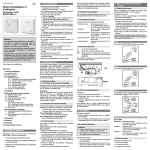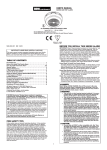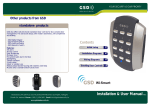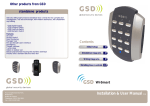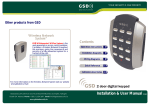Download Installation and Operating Instructions
Transcript
U 468 931 002 933-01 Installation and Operating Instructions Radio receiver INSTAT 868-a1... 2. Features ● ● ● ● ● ● ● ● ● ● ● ● ● ● Attention! The radio receiver may be installed only by a specialist in compliance with the circuit diagram enclosed in the top housing cover or in compliance with these instructions. The current safety regulations must be observed. In order to achieve class of protection II, adequate installation measures must be taken. This radio receiver which can be installed separately, is designed exclusively for temperature control in dry and closed rooms and standard environments. The radio receiver has radio interference suppression in accordance with VDE 0875 and EN 55014 and operates in accordance with IC (EN 60730). Errors possible / Subject to alterations. Contents: 1. Use 2. Features 3. Function description 3.1 Basic Functions 3.1.1 Function - 1, - Switching mode 3.1.2 Reversing the control action 3.1.3 Deleting the radio links 3.1.4 Identifying active links 3.1.5 Testing the radio link range 3.1.6 System demonstration 3.1.7 Signal lamp function 3.1.8 Jumper function 3.2 Enhanced functions 4. Installation 5. Commissioning 5.1 Establishing the radio link 5.2 Valve test 5.3 Power failure 5.4 Quit/Reset 5.5 Faults 5.5.1 Double addressing 5.5.2 Short time losses of the transmission signal 5.5.3 Long time losses of the transmission signal 5.6 Troubleshooting 6. Technical data 6.1 Technical data INSTAT 868-a1A, relay 16 a 6.2 Technical data INSTAT 868-a 1mA, relay 200 mA 6.3 Technical data INSTAT 868-a1T, Triac 7. Dimensions 8. Wiring diagram 9. Examples 10. Short form instructions 1. Use Receiver for INSTAT 868-r… (radio transmitter) for switching: ● actuators of radiator heaters ● heating systems with switching applications ● circulating pumps (decentralised pump control) ● etc. Volt-free switching (relay version) of: ➱ 24 ... 250 V AC loads ➱ 5 V ... 250 V UC low-voltage current signals Noiseless switching of 230 V AC (0,8 A) by means of a Triac (non-volt-free) Output functions (optional): ➱ Heating ON/OFF ➱ Temperature setback ON/OFF e.g. for boilers or other controllers ➱ Pump control for up to 6 transmitters, extendable Reversing of control action for: ➱ connecting actuators “currentless open” instead of “currentless closed” ➱ changing from summer to winter mode (cooling instead of heating) Valve test function Radio test and system demonstration One transmitter can control several receiver modules Self-learning address settings through “Learning mode” in the transmitter button for setting of functions Reset button Signal lamp indicates initial state, faults etc. Monitoring of valid radio link Audible signal in case of faults (can be switched off) Emergency operation in case of loss of radio link 3. Function description The INSTAT 868-a1 receiver converts radio signals received from a transmitter, e.g. INSTAT 868-r … into control signals for loads. The loads are switched by means of a relay or a Triac. The switching state of the output is indicated by a signal lamp. For switching characteristics, see Installation instructions for the transmitter under item “Function description”. For controlling the electric loads, the output can be configured in different ways. 3.1 Basic Functions 3.1.1 Function - 1, - switching mode “One transmitter controls one switching output” One transmitter controls the output for heating/ cooling ON/OFF. This function is active, if jumper BR 1 is closed. Note: For heating systems, which are in stand by mode during summer time (e.g. electric heating), the valve protection has to be switched off (in the transmitter). If the valve protection is not switched off, a daily 3 min. heating will take place. 3.1.2 Reversing the control action The switching characteristics of the output and the signal lamp are reversed in respect of all functions (also pump control). Due to this feature, the following functions can be implemented. ● connecting actuators “currentless open” ● changing from summer to winter mode (cooling instead of heating) For cooling (summer mode) or actuators “current less open”: single-pole plugging of BR 1 jumper (One-pole plugging prevents loss of jumper) For heating (winter mode) (= as delivered condition) double-pole plugging BR 1 jumper . 3.1.3 Deleting the radio links To delete all radio links and functions or to select a different function in compliance with sections 3.1 to 3.4: 1. Press the z button and the ”Reset” button simultaneously 2. Release the “Reset” button, then the z button 3. Press the “Reset” button. Only during subsequent programming of the first new link all other links and functions are deleted. 3.1.4 Identifying active links After pressing the “Reset” button, the programmed links are indicated by brief flashing. Several links are indicated by repeated flashing. 3.1.5 Testing the radio link range To determine the radio link range, follow this: Set the transmitter to “Learning mode”: 1. Press the z button and the ”Reset” button simultaneously 2. Release the ”Reset” button first, then the z button The signal lamp lights up. The signal tone and the output operate in the switching mode, approx. 2 sec. ON, 8 sec. OFF. 3. Now, while holding the transmitter in your hand, walk away from the receiver until you reach the point where the signal tone is no longer audible and the signal lamp stops flashing. This point is the maximum possible radio link range. 4. Always terminate this function by pressing the “Reset” button. 5. Quit the “Learning mode” on the transmitter As far as a free transmitter is used, existing radio links will not be affected. Note: All links must be reprogrammed on completion of “Testing the Radio link range”. 3.1.6 System demonstration To demonstrate the radio range, see section 3.1.3 “Testing the radio link range”. If necessary, a lamp can be connected to the output. 3.1.7 Signal lamp function The signal lamps provide the following information: ● Output state… ON/OFF in a interval of 10 min.or steady light may be possible ● Faults… Blinking; Duration varies depending on type of fault ● Learning mode…ON until the link is established or the Reset button is pressed ● Valve test… ON as long as the “Reset” is pressed ● Testing the radio link range... Flashing, 10 sec. interval ● Monitoring of channels… after “Reset” 5. Commissioning Before commissioning, delete all radio links as described under section 3.1.3. BR 1 is closed 5.1 Establishing the radio link On completion of the installation work, a link between the INSTAT 868-r… transmitter and the radio receiver must be established. To do this, follow this: (see fig. 1) a) Set the transmitter to “Learning mode” (see Operating instructions for transmitter) b.1 For function-1, – switching mode – activate “Learning mode” on transmitter (A) to do this: press the z button briefly A signal tone sounds, the signal lamp lights up and the output is switched on briefly. When the transmitter is recognised, the signal tone ceases to sound and the signal lamp extinguishes. b.2 For function-2, – pump control – proceed as described under b.1. However, at least 3 transmitters must be programmed. If, for instance, only one transmitter is to be used, then this one must be programmed three times, without quitting the “Learning mode” on the transmitter b.3 For function - 3, – time switch – proceed as described under b.1, this transmitter must, however, be programmed twice, without quitting the “Learning mode” on the transmitter c. When the transmitter is recognised, the signal tone ceases to sound and the indicator lamp extinguishes. d. Terminate the “Learning mode” on the transmitter e. Test the radio links which have just been established (see Table within section 5.6 for points 4, 5) Note: Before programming a second function or the reprogramming of the same function, execute the instructions in section 3.1.3 “Deleting the radio link.” Fig. 1 One transmitter (INSTAT 868-r) controls one receiver. INSTAT 868-r1 1 3.1.8 Jumper function J1: open to reverse control action = cooling J2: open to switch off the beeper BR1: closed = only switching mode possible open = all functions possible One-pole plugging prevents loss of jumpers A INSTAT 868-a1 3.2 Enhanced Functions The functions ● pump logic control ● Time switch (Maser/Slave) ● pilote output are described in the additional manual „Enhanced functions for 1 channel receiver INSTAT 868-a1, no. 468 931 012 739. These functions are available by opening Jumper BR1. Fig. 2 One transmitter (INSTAT 868-r) controls one receiver INSTAT 868-r 1 A 4. Installation Installation: e.g. ● In distribution board on DIN rail (by snap-on mounting SBF 3/6) ● Directly on the wall ● If necessary, on conduit box , by means of ARA 1S pattress. Electrical connection To make this connection, follow this: ● Loosen cover fastening screw ● Remove top part of housing ● Make the connection in compliance with the circuit diagram (see top part of housing) ● If necessary, knock out penetration for actuator drive cable (lower right-hand corner) Make sure that the strain relief for the actuator drive connection fits tight. INSTAT 868-a1 Fig. 3 One transmitter (INSTAT 868-r) controls a couple of receivers INSTAT 868-a1 A INSTAT 868-r1 A INSTAT 868-a1 The radio receiver is not suitable for switching “safety extra-low voltage” (SELV). 1 5.2 Valve test When the z button is pressed: ● The output is switched on (as long as the z button is pressed) ● The signal lamp lights up ● The signal tone sounds After releasing the z button, the “Reset” button must be pressed within 10 seconds. As a result of this, the signal lamp extinguishes and the signal tone ceases to sound. After 10 seconds, the “Learning mode” starts; a link would be established to a transmitter which happens to be in the “Learning mode”. 5.3 Power failure If there is a power failure in the transmitter or in the receiver, all data is saved. When power supply is restored, normal operation is resumed. 5.4 Quitting / Reset To – quit the “Learning mode” – acknowledge a failure or – terminate the Radio link range test or – terminate the valve test – in the event of any other inexplicable phenomena push the “Reset” button. This restores the output to its initial state (also reversed control action). When new 6. Common technical data actuating signals are received (possibly after 10-20 min.), the output will return to its previous state. Any existing radio link will be maintained. 5.5 Faults If faults occur, an alarm is triggered. In this case, the signal lamp flashes with varying duration, if necessary, a signal tone sounds. 5.5.1 Double addressing In this case, the signal lamp shows a longer flash of approx. 0.7 sec. ON, 0.3 sec. OFF. It is cancelled by reprogramming one of the transmitters. The signal tone sounds. 5.5.2 Short time losses of the transmission signal If the transmitter fails to receive an actuating signal within a period of 1 and up to approx. 10 hours, the signal lamp blinks permanently one time. No signal tone sounds. When recurrence of the transmission signal, the alarm automatically ceases. 5.5.3 Long time losses of the transmission signal If the receiver has not received an actuating signal for more than 10 hours, the signal lamp shows a permanent short flash. The signal tone sounds. 7. Dimensions When the transmission signal recurs, the alarm automatically ceases to sound. For all types of faults, the following applies: ● The output is switched with 30 % (3 min. ON, 7 min. OFF), this means heating with 30 % of capacity. ● FUNCTION 2: In the alarm mode the pump operates permanently (even if one transmitter has failed to operate). Note: ● In the case of heating units which are in a stand-by mode in the summer, for instance, electric heaters, the valve protection (in the clock thermostat) must be switched off. Otherwise heating would take place with 30 % capacity when a fault occurs. ● The signal tone can be switched off permanently by removing jumper J2 (one-pole plugging prevents loss of jumper). ● The flashing signal lamp indicates the alarm condition, not the control state ● After a power loss in the transmitter or in the receiver, normal operation is resumed. ● Under unfavourable local conditions it is possible that the radio link between the transmitter and the receiver is insufficient, for instance, if the receiver is arranged in an interference-proof metal housing. Please check whether the situation improves when the transmitter is arranged in a different position. For checking the radio link, see section 3.1.7 5.6 Troubleshooting 1. Valve does not open: ➱ Has it been properly wired up? ➱ Has the radio link been established (see section 5.1) ➱ See point 3 in the Table as well as point 4 onwards ➱ Press the Reset button (see 5.4)! 2. Signal lamp flashes and possibly a beeper is sounding ➱ For basic fault procedures, see 5.5 ➱ “Learning mode”, valve test, radio range test have not been interrupted! (see sections 5.1, 5.2, 3.1.7) ➱ Two transmitters are transmitting with the same address; reprogram one of the radio links! ➱ No radio link, see point 7 in the Table. ➱ In the case of inexplicable faults it is recommended to press the “Reset” button on the receiver and, if necessary, on the transmitter (see section 5.5.1) If the radio link does not work, check the following: Operating voltage 230 V AC (195…253 V) 50/60 Hz Direction of action = normal = jumper BR 1 is plugged to two poles. Check the following: Yes Power consumption Approx. 12 VA 1. Receiver. Is power supply OK? Continue with 2 Check fuse, if necessary Operating temperature 0…+40 °C –20 …60 °C Transmission signal is missing Antenna Internal 2. Receiver: Does the signal lamp flash? Can the warning tone be heard? (wait for an hour, if necessary) Continue with 4 Storage temperature Push-button for programming for reset 3. Transmitter: Is the battery OK? Continue with 4 Insert new batteries 1 1 4. Transmitter: adjust to 30°C. Is the output switched on after approx. 30 sec? (Lamp light up). Continue with 5 The output was already switched on. Continue with 5 or the transmission signal is missing, continue with 6 or wrong function, see 5.1 5. Transmitter: adjust to 5 °C. Is the output switched off after approx. 30 s (Signal lamp does not light up) Everything OK The transmission signal is missing, continue with 6 or wrong function, see 5.1 6. Transmitter-actuator-receiver: Check wiring, if necessary, reprogram the connection to the Radio receiver. Has the remedial action taken under points 4 and 5 been successful? Everything OK Continue with 7, if necessary check the Radio link range, see section 3.1.7 “Testing the radio link range” 7. Reduce the distance between the receiver and the transmitter to approx. 2 m. The thermostats are working properly Check environment for other RF-signals! The transmitter or the Radio receiver are defective Signal lamp 1 Protection class of housing IP 30 (Moisture condensation not permitted) 8. Circuit diagram Class of protection II*** (see page 1) INSTAT 868-a1A / INSTAT 868-a1 mA (Relay) Weight Approx. 100 g 6.1 Technical data INSTAT 868-a1 A, relay 16 A Model No. INSTAT 868-a1A EDP No. 0536 30… Load circuit: Relay, 1 NO contact, volt-free* 16 A max. cos ϕ = 1 2 A max. cos ϕ = 0,6 24 ... 250 V AC Number of actuators (3 W electrothermal) 230 V AC AC 24 V Model No. INSTAT 868-A1mA EDP No. 0536 35… Load circuit: 5…250 V UC Short form instructions for the radio receiver INSTAT 868-a 20 max. 8 max. 6.2 Technical data INSTAT 868-a 1 mA, relay 2.5 mA Relay, 1 NO contact, volt-free* 2,5 mA…200 mA cosϕ = 1 Note: *) The volt-free contact of this mains-operated radio receiver do not ensure the requirement for the use of safety extra-low voltage (SELV). **) The Triac is not protected. Overload or short circuit of the load result in the destruction of the Triac. Switching off the load is accomplished in zero current flow Thus, a contactor can be controlled directly, without the need to take any additional measures. ***) Will be complied with, if the radio receiver is installed on a level, non-conducting surface. No Note Absolutely trouble-free operation of the radio link in accordance with the state-of-the-art technology is not always guaranteed. Therefore, we recommend checking its proper functioning at the respective place of installation. RF approval has been obtained in the following countries: Germany, France, England, Netherlands, Norway, Austria, Switzerland, Belgium, Luxembourg, Denmark, Sweden, Finland, Spain, Italy, Ireland, Island, Portugal. 0125 Delete the radio link See 3.5 Test the radio range 3.1.5 Function 1 “Switching mode” (Jumper BR1 has to be closed) 5.1 Function 2 “Pump control” 5.1 • • Function 3 “Time switch” Valve test 5.1 • • • 3.1.2 • • Press z button + “Reset” button simultaneously After that, release z button Press “Reset” button Adjust transmitter to “Learning mode” Press z button + “Reset” button simultaneously After that, release “Reset” button and then the z button Signal lamp lights up - signal tone + output operate in the switching mode (short ON - long OFF) Press “Reset” button for termination Adjust transmitter to “Learning mode” Briefly press z button Signal tone sounds - signal lamp + output switch on briefly Transmitter recognised - signal tone + signal lamp extinguish Like function 1 However, programme at least 3 transmitters or programme the one transmitter 3 times Like function 1 however, programme the one transmitter twice Press the z button - output switches ON as long as z button is pressed Release z button + press “Reset” button within 10 sec. for termination Summer mode (currentless open) J1 one-pole plugging Winter mode (currentless closed) J1 double pole plugging 5.5 • • • Brief losses of control signal (from 1 hour up to 10 hours) Longer losses of control signal (more than 10 hours) Double addressing - reprogram the radio link 5.2 • • • • • • • • • • • • • Reversing control action Signal lamp: Blinking + signal tone sounds Blinking + signal tone Double blinking


